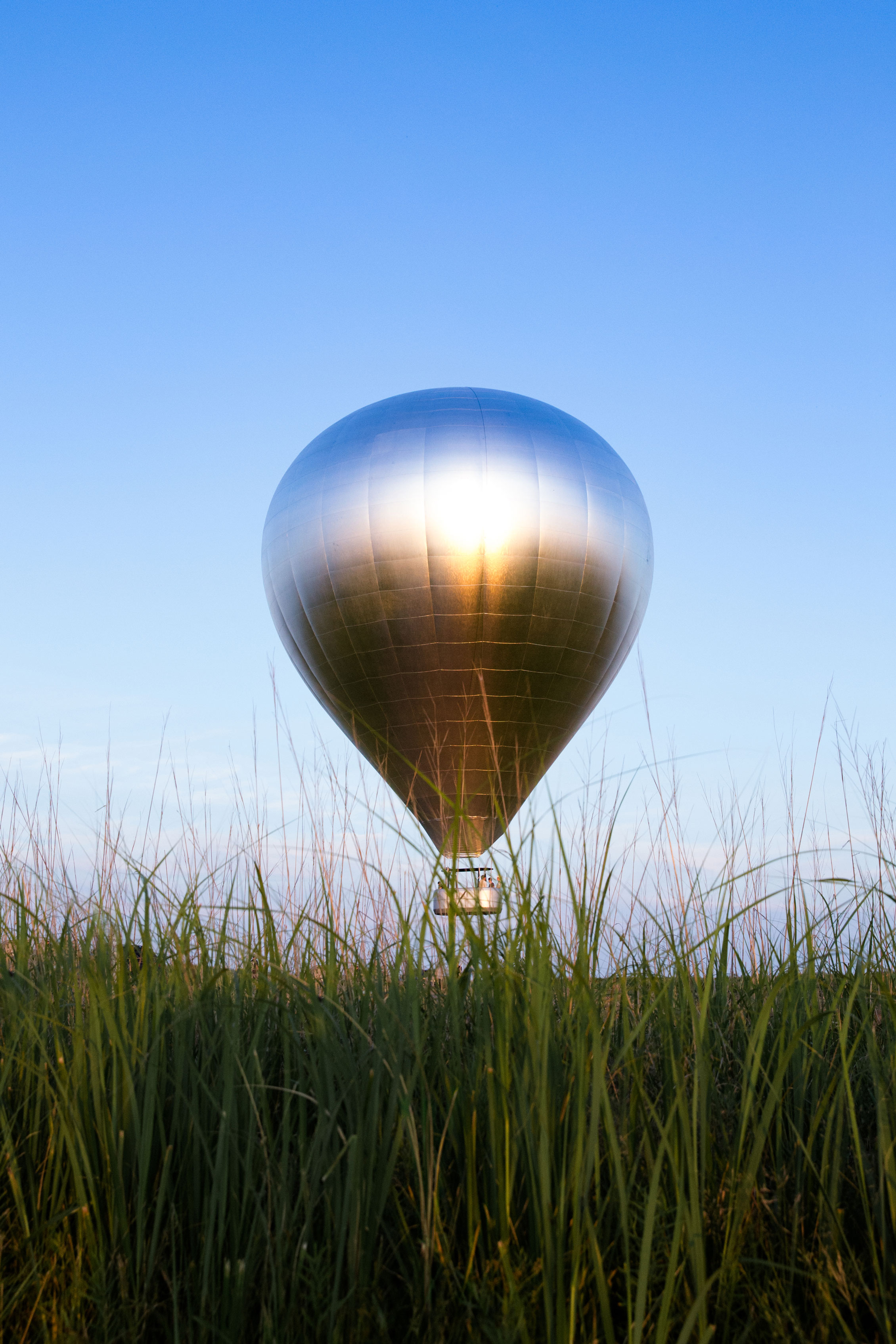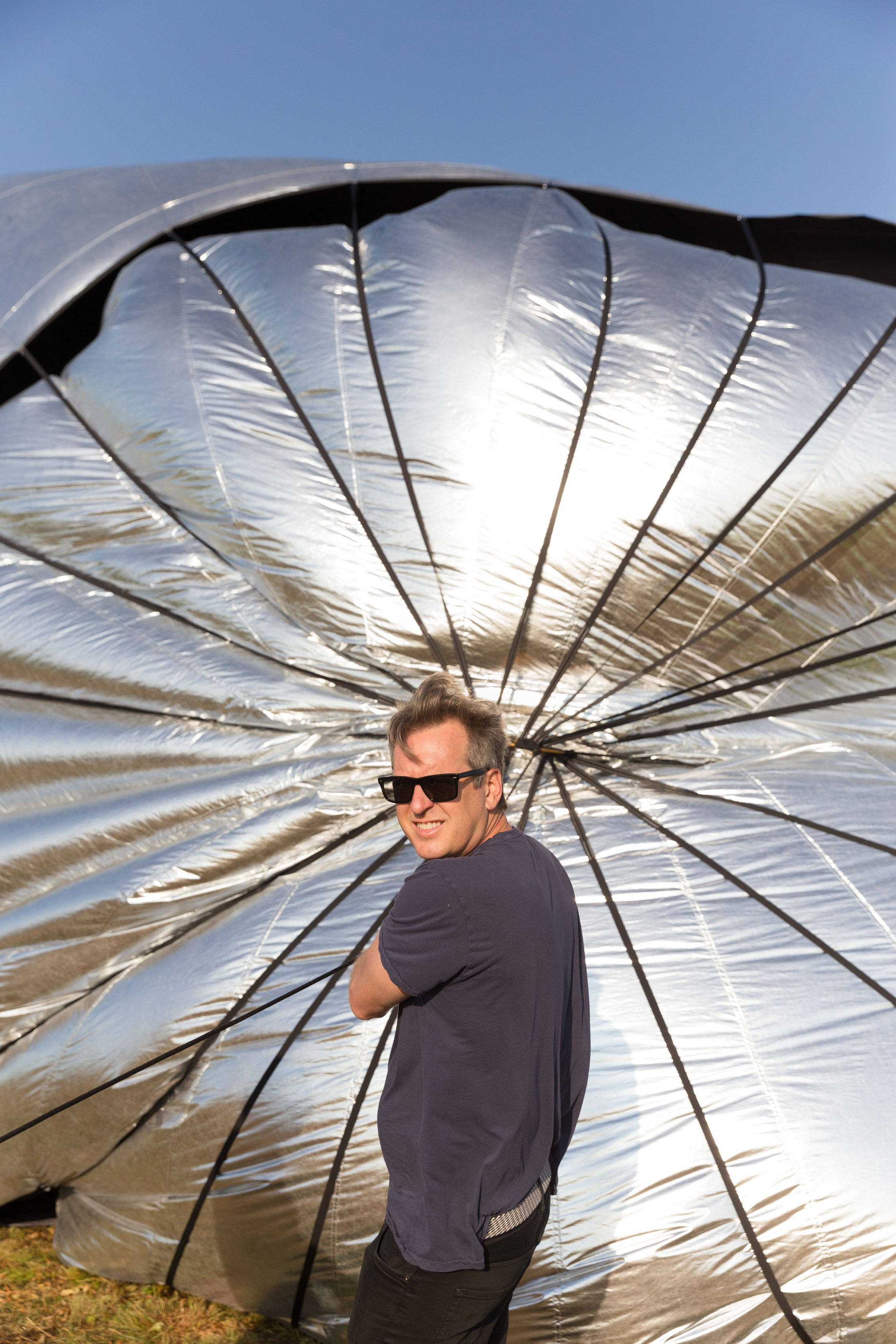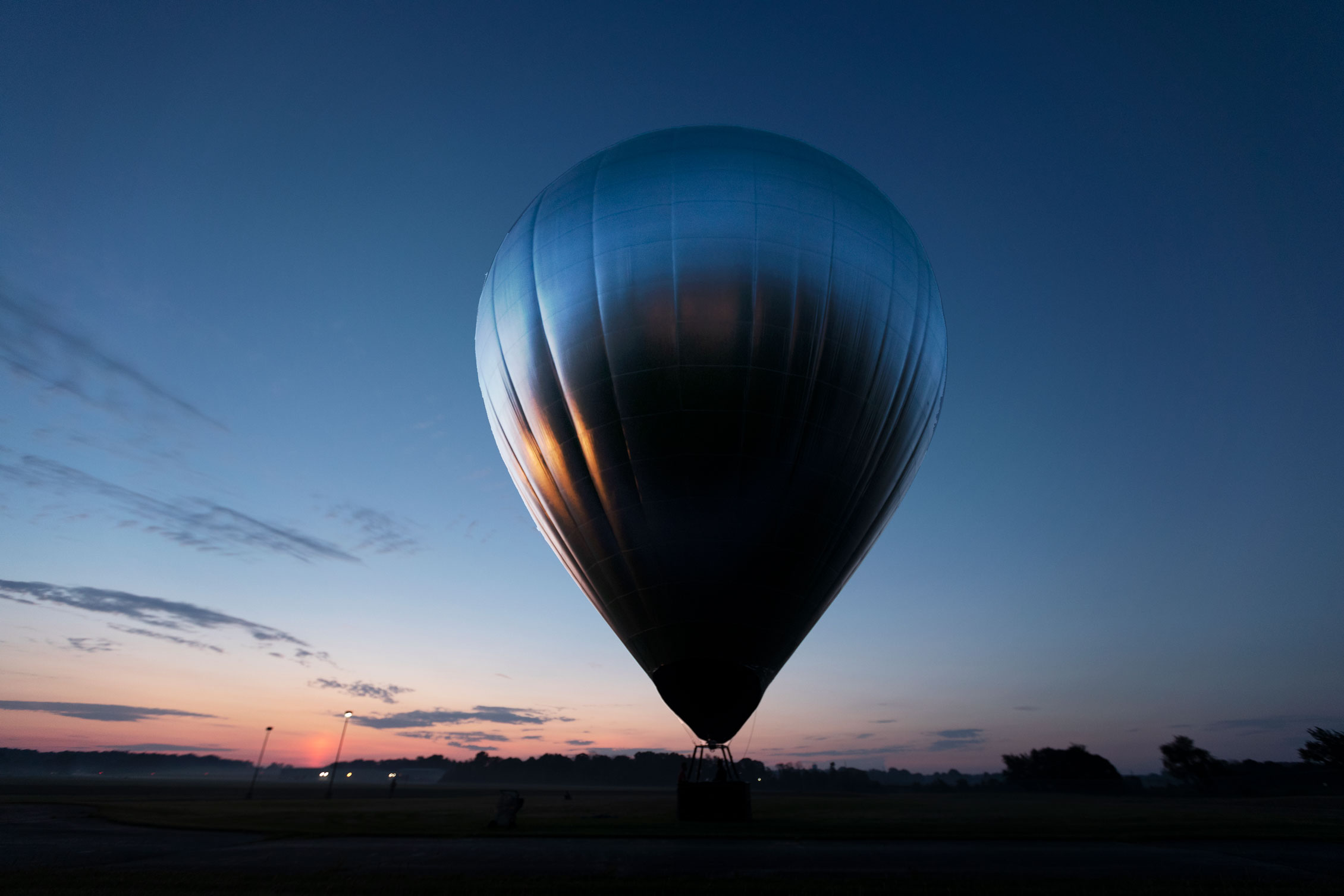
Doug Aitken’s latest project, New Horizon, looks so good on the screen I was skeptical of the real thing. The 100-foot reflective hot air balloon has been making stops throughout Massachusetts for the past month, hosted by The Trustees—a nonprofit land conservation trust founded in 1891 by the prescient landscape designer Charles Eliot. Eliot foresaw the ways in which industrialized capitalism would devour nature and went about setting up an infrastructure of land protection that now manages more than 27,000 acres of land throughout the state. I caught Aitken and his balloon on their first stop at the Longpoint Wildlife Refuge on Martha’s Vineyard, a 600-acre oceanfront stretch of dunes that formed into a prairie following the last ice age, around 12,000 years ago. I arrive on a Saturday morning, having missed the previous night’s talks with Sir Norman Foster and Sarah Morris: the balloon can be thought of as the material focal point of Aitken’s vision for a radical cross-disciplinary meeting of the minds centered around the ever-confounding concept of the future. It falls in a space somewhere between institutional, public and idealistic in which success tends to be elusive. Yet, Aitken’s New Horizon is successful, even when it technically isn’t.
The sunrise launch, planned for Sunday morning, brings a crowd who have paid for mimosas, breakfast and rides in the balloon. We gather around talking and trying to be discreet as we watch the crew attempt to launch the apparatus in a scene curator Pedro Alonzo likens to men building a fire—lots of opinions. Conditions aren’t right to get the balloon in the air, but nobody seems to mind that much. We’re in a beautiful place, the sun is shining, there are waves behind us and even deflated the balloon makes a good background for Instagram content. That evening, we all return to the reserve for talksby two scientists from Woods Hole Research Center, Spencer Glendon and Chris Neill, and live musical performances by Helado Negro and Kelsey Lu.
Until this point I definitely liked Aitken’s balloon, but its potential beyond being really cool wasn’t clear. As soon as Glendon, an economic historian whose expertise is in climate change, started speaking, it came together. Glendon told the story of Martha’s Vineyard, zipping through the big bang and the ice age to its years as a center for whaling and bringing us to its present role as a place of leisure. “We’re all sitting in a place that will not exist not that long from now,” he concluded. “For 40 years, climate scientists have been right about a variety of things. It is mankind’s first good forecast. It’s the only one that allows us to look over the horizon. It would be a great shame if we kept being too afraid to look.” I realized that exactly where we were sitting would not exist had Eliot not thought about the future and the place of humans within the landscape, and Aitken’s New Horizon came to feel like it had cracked through whatever feels trite or daunting or hopeless about the coming decades.

Aitken and I spent a few minutes talking behind a car in a field, a few birds in sight.
Let’s start with this idea of horizon: it’s both an end and a beginning. Where did that idea came from as the title of this project? It’s interesting to think about that question sitting here where we can hear the Atlantic Ocean behind us and feel the wind coming in. With this project I really wanted to create something that was an artwork in flux, something that was changing continuously, that wasn’t fixed and frozen and in one place. I was thinking about the idea of the landscape and when we think about the landscape, we think of the horizon. It’s the one absolute. But I think that word has many meanings and it is also kind of a metaphor for the future: what doesn’t exist yet, what we see and what kind of abstraction or ambiguity we see in front of us. I wanted the project to talk about where we’re going as individuals, as a culture, and to act in a way that wasn’t about one medium—it’s not just about art or music or film, but a kind of a space where there could be this crossover, so tonight we have Spencer Glendon, who is an expert on climate change and then Kelsey Lu is performing after. I am interested in the idea that the work could create these dialogues that can move across the landscape. I’ve thought about this for a while and when I started talking with the curator Pedro Alonzo I wasn’t drawn to the idea of one fixed work in one place because I felt like it would run the risk of being too easy to consume. I felt more that if we could be sculpting with time instead of something physical and we could make something time-based we could create a sequence of experiences and this moving, roving narrative that you could tap into.
When did the idea of the future become of interest? Is there an idea around the idea of the future that you’re hoping to stimulate? The subject itself is so broad. I don’t have a single entry point that I’m looking for, but I am looking for the wider discussion and that idea that we can be using this project to talk about ecology and landscape as much as we could be talking about how we build cities in the future. The future is the great unknown—the future is the horizon. Where are we going and how can we open up larger discussions and how can we talk about it so we can actually share and create a roadmap that has some vision to it instead of moving blindly? All these things are connected, whether it’s ideas of the landscape or art or music, yet in society it’s so siloed. That often happens for commercial reasons. Artists make work, but there’s almost like an invisible shield around it that kind of creates a detachment so the work isn’t able to move in multiple directions. That’s true for so much of the arts because they are these industries that people protect and make a living from, but if that barrier can get removed and there’s an immediate conversation between you and I in two chairs in a field right now, then there’s something fresh to it, possibilities.
Yes, for sure. You’re an artist who has long pushed against the gallery structure and this is a piece that can have a critical reading but is also broadly of interest to people who might not go to a gallery. How do you navigate those two roles? It goes back to the root system of art-making and having ideas and questions that you can develop into something that pushes and pushes and maybe becomes something that’s more urgent and more formed and those ideas push into material or de-material. For me that’s where art starts. It’s not about defining yourself as someone who stretches canvas and makes paintings—that’s fine, but I work in a different way and I think that allows for me to think, maybe this project is just better if it’s a musical piece or if it’s a sound piece. Or this other thing over here is very interesting if it’s physical and sits here for 50 years and gradually changes, maybe that’s interesting. The mediums are dictated by the concepts.
Who are the artists you think of as your teachers? I remember being stuck in an elevator with Félix González-Torres and all of a sudden we had time and we were talking about art. I was really young and I said, ‘What’s your studio?’ And he said, ‘My studio is a table, a telephone and the New York Times.’ And I thought that was such an amazing way to look at art-making—that art can be connectivity and information and yourself.

So what’s your studio? We’re in it! A table, a glass of water and a cell phone. To me, if an artwork is something you’ve already conceived beforehand, it’s not really worth doing. I’m much more interested in the process and the journey, whether that’s metaphoric or physical. That idea that the artwork can take you and hold you and put you in situations where maybe you’re uncomfortable, but maybe it’s harmonious, but you don’t quite know the outcome and in a sense the work starts making itself and you’re kind of almost in the service of the concept.
As someone who prefers the concept, how do you deal with the aesthetic? This balloon is also obviously beautiful. It was a mistake.
So there’s no aesthetic consideration at all? Well with this I wanted it to reflect to some degree because I felt like that would allow it to live, and there’s the idea that you can have this object and if it’s in a direct living relationship with what’s around it then it’s a little harder to consume maybe, it’s a little less material and less physical.
What’s going to happen with this after this summer? I don’t know. We’re just trying to get through the next few weeks. On Friday, we were out on this sand dune and the water is lapping over it and the sun starts setting and these rays of amber light start cutting across the field. Kelsey Lu was performing and in the distance we start seeing this object rising from the field and it’s a 100-foot sculptural object that no one expected. We didn’t know it was going to happen and we see this thing appear almost like it’s a phantom, this kind of mirage. It was almost dark and it was so surreal seeing this object breathing, pulsing, reflecting and then going back down and vanishing again. It’s moments like those that you can’t predict or choreograph. It was such a shock and surprise to most of us who are part of this. I like the idea that we can curate and bring people together, but I also like the idea that there’s a randomness to it. With the balloon, you know where you’re going to take off but you don’t know where you’re going to land. You could land in a field or you could land in a Walmart parking lot.
That’s part of what I struggle with in thinking about the future—it’s like no matter how much planning or thinking we do, we just don’t know, so where do we even start to have these conversations? Maybe that’s the point of the conversation—just to have the conversation.



